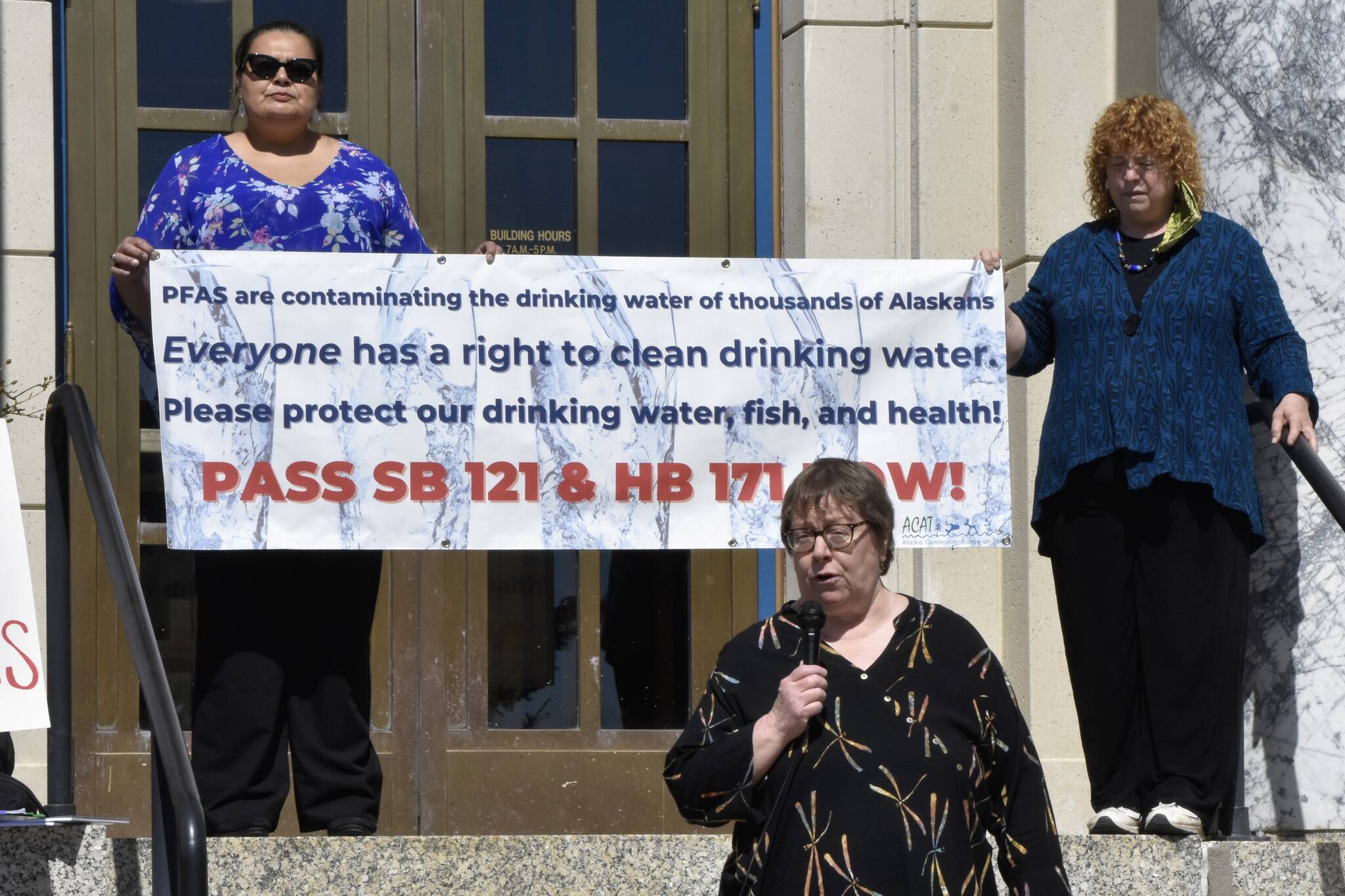Alaskans from Gustavus to Utqiaġvik gathered in front of the Alaska State Capitol Thursday, calling on lawmakers to pass bills addressing contamination from PFAS chemicals, often found in firefighting foams.
Per- and polyfluoroalkyl substances — commonly known as PFAS chemicals — have been called “forever chemicals” because they don’t break down and can easily contaminate local environments, including drinking water. The chemicals are used in fire-fighting foams the Federal Aviation Administration requires be kept at airports.
Once in a community’s water, PFAS chemicals have also been shown to enter people’s bloodstreams, and the chemicals have been linked to higher rates of cancer and other health issues.
“Three of my closest friends have been taking thyroid medication that they’ve taken since their teens,” said Sarah Thomas, originally from Utqiaġvik.
Thomas, who is pregnant, said there were high rates of cancer and thyroid issues among her friends and family and called PFAS contamination a life and death issue.
“We need our government to act now,” Thomas said.
In 2021, the state of Alaska announced it was joining a lawsuit against DuPont, a major PFAS manufacturer that the state accuses of providing false information about the danger of its products.
Most of Alaska’s known contamination sites are near airports or military installations, according to Pamela Miller, executive director of Alaska Community Action on Toxics, an advocacy group that lobbies for better PFAS regulation and clean up. The Alaska Department of Environmental Conservation’s mapping of PFAS contamination show most locations are near airports.
[With thin margins in the House, floor debate is delayed]
“We know these chemicals have severe health effects even at very low levels,” Miller, an environmental scientist, said. “DEC is really misrepresenting and I think casting denial about the definitiveness of the science.”
According to DEC, the department works with the Department of Health and Social Services and the Department of Transportation and Public Works to provide clean drinking water and assess the scope of the contamination in affected communities. The agencies are currently working on responses to contamination in Fairbanks, Gustavus, Dillingham, King Salmon, Moose Creek, North Pole and Yakutat, according to DEC.
ACAT members were calling on the Legislature to pass either Senate Bill 121 or House Bill 171, congruent bills sponsored by Juneau’s Sen. Jesse Kiehl and Rep. Sara Hannan, both Democrats. Those bills would establish a minimum level of acceptable contamination specific to Alaska, Kiehl said, and provide an alternate source of drinking water for contaminated communities.
Miller said the state currently only tests for two kinds of PFAS chemicals, but there are several more than can cause health issues. ACAT has conducted its own testing, Miller said, and found PFAS contamination outside of the sites identified by the state.
“PFAS was found in Anchorage lakes including DeLong Lake, Little Campbell Lake, Sand Lake, Sundi Lake, and Spenard Lake/Lake Hood, which contained the highest levels at 674.7 parts per trillion (ppt),” a recent study from ACAT found. “That is nearly ten times (U.S. Environmental Protection Agency’s) lifetime health advisory of 70 ppt.”
PFAS contamination has been detected in Juneau, but not near sources of drinking water, according to the City and Borough of Juneau.
Tiffany Larson, director of DEC’s Division of Spill Prevention and Response, said there are thousands of PFAS chemicals and the state only regulates two, in line with EPA standards. In an interview with the Empire, Larson said the department is expecting updated PFAS guidelines from the EPA this year which could make the changes the proposed bills are seeking to enact.
“The department expects the new rules to have likely lower limits for two of the (PFAS) compounds,” Larson said. “We get the concern that the public has the desire for those clean lines, but the scientific community just isn’t at a point where we can say yes for all these compounds, and we look to EPA for that.”
Larson said the department works with DOT and the Department of Fish and Game on testing for PFAS, mainly around airports where the chemicals have been used. Capital City Fire/Rescue has stopped using the foam in training exercises, but it does keep the materials available.
Speaking to a handful of demonstrators in front of the Capitol, Hannan said the longer the state waits to begin cleaning up, the worse the contamination will become.
“The more you learn the worse it gets,” Hannan said of PFAS chemicals.
Joann Lesh, an ACAT member from Gustavus where PFAS chemicals have been found in residents’ blood, said she brushes her teeth with bottled water.
But the bills are stalled in committee, and according to Kiehl, there’s disagreement between lawmakers and DEC over how much the bill will cost the state. The Legislative session ends May 18, and the House of Representatives is currently bogged down in debate over the state’s budget bill, but Miller said she was still hopeful lawmakers will act.
“Similar bills have been introduced since 2019,” Miller said. “The cost of inaction is astronomical, the costs are going to increase exponentially if no action is taken, it doesn’t make any sense to kick this down the road.”
• Contact reporter Peter Segall at psegall@juneauempire.com. Follow him on Twitter at @SegallJnuEmpire.

